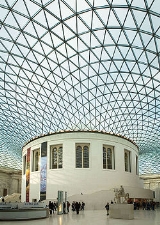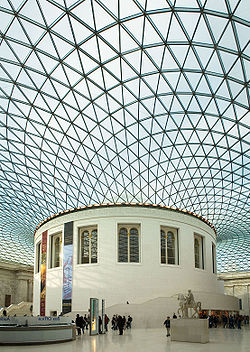
Queen Elizabeth II Great Court
Encyclopedia

Quadrangle (architecture)
In architecture, a quadrangle is a space or courtyard, usually rectangular in plan, the sides of which are entirely or mainly occupied by parts of a large building. The word is probably most closely associated with college or university campus architecture, but quadrangles may be found in other...
of the British Museum
British Museum
The British Museum is a museum of human history and culture in London. Its collections, which number more than seven million objects, are amongst the largest and most comprehensive in the world and originate from all continents, illustrating and documenting the story of human culture from its...
in London
London
London is the capital city of :England and the :United Kingdom, the largest metropolitan area in the United Kingdom, and the largest urban zone in the European Union by most measures. Located on the River Thames, London has been a major settlement for two millennia, its history going back to its...
was redeveloped to a design by Foster and Partners
Foster and Partners
Foster + Partners is an architectural firm based in London. The practice is led by its founder and Chairman, Norman Foster, and has constructed many high-profile glass-and-steel buildings....
, from a 1970s design by Colin St John Wilson
Colin St John Wilson
Sir Colin Alexander St John Wilson, FRIBA, RA, was a British architect, lecturer and author. He spent over 30 years progressing the project to build a new British Library in London, originally planned to be built in Bloomsbury and now completed near Kings Cross.-Early and private life:Wilson was...
, to become the Queen Elizabeth II Great Court, commonly referred to simply as the Great Court, during the late 1990s. It was opened by Queen Elizabeth II
Elizabeth II of the United Kingdom
Elizabeth II is the constitutional monarch of 16 sovereign states known as the Commonwealth realms: the United Kingdom, Canada, Australia, New Zealand, Jamaica, Barbados, the Bahamas, Grenada, Papua New Guinea, the Solomon Islands, Tuvalu, Saint Lucia, Saint Vincent and the Grenadines, Belize,...
in 2000.
Description
The court has a tessellatedTessellation
A tessellation or tiling of the plane is a pattern of plane figures that fills the plane with no overlaps and no gaps. One may also speak of tessellations of parts of the plane or of other surfaces. Generalizations to higher dimensions are also possible. Tessellations frequently appeared in the art...
glass roof designed by Buro Happold
Buro Happold
Buro Happold is a professional services firm providing engineering consultancy, design, planning, project management and consulting services for all aspects of buildings, infrastructure and the environment, with its head office in Bath, Somerset...
and executed by Waagner-Biro, covering the entire court and surrounds the original circular British Museum Reading Room
British Museum Reading Room
The British Museum Reading Room, situated in the centre of the Great Court of the British Museum, used to be the main reading room of the British Library. In 1997, this function moved to the new British Library building at St Pancras, London, but the Reading Room remains in its original form inside...
in the centre, now a museum. It is the largest covered square in Europe
Europe
Europe is, by convention, one of the world's seven continents. Comprising the westernmost peninsula of Eurasia, Europe is generally 'divided' from Asia to its east by the watershed divides of the Ural and Caucasus Mountains, the Ural River, the Caspian and Black Seas, and the waterways connecting...
. The glass and steel roof is made up of 4,878 unique steel members connected at 1,566 unique nodes and 1,656 pairs of glass windowpanes making up 6,100m2 of glazing; each of a unique shape because of the undulating nature of the roof.
Controversially, some of the stone in the court is from France
France
The French Republic , The French Republic , The French Republic , (commonly known as France , is a unitary semi-presidential republic in Western Europe with several overseas territories and islands located on other continents and in the Indian, Pacific, and Atlantic oceans. Metropolitan France...
, rather than being Portland Stone
Portland stone
Portland stone is a limestone from the Tithonian stage of the Jurassic period quarried on the Isle of Portland, Dorset. The quarries consist of beds of white-grey limestone separated by chert beds. It has been used extensively as a building stone throughout the British Isles, notably in major...
from southern England
England
England is a country that is part of the United Kingdom. It shares land borders with Scotland to the north and Wales to the west; the Irish Sea is to the north west, the Celtic Sea to the south west, with the North Sea to the east and the English Channel to the south separating it from continental...
as agreed in the original contract with the masons.
Within the Great Court, there are shops and a café. It remains open after the British Museum itself has closed for the evening. The court acts as a central linking point for the museum, somewhat like I. M. Pei
I. M. Pei
Ieoh Ming Pei , commonly known as I. M. Pei, is a Chinese American architect, often called a master of modern architecture. Born in Canton, China and raised in Hong Kong and Shanghai, Pei drew inspiration at an early age from the gardens at Suzhou...
's Louvre Pyramid
Louvre Pyramid
The Louvre Pyramid is a large glass and metal pyramid, surrounded by three smaller pyramids, in the main courtyard of the Louvre Palace in Paris. The large pyramid serves as the main entrance to the Louvre Museum...
in Paris
Paris
Paris is the capital and largest city in France, situated on the river Seine, in northern France, at the heart of the Île-de-France region...
.
Construction
The central courtyard of the British Museum was occupied by the British LibraryBritish Library
The British Library is the national library of the United Kingdom, and is the world's largest library in terms of total number of items. The library is a major research library, holding over 150 million items from every country in the world, in virtually all known languages and in many formats,...
until 1997 when it moved to St Pancras. At that time the entire courtyard was filled with bookshelves, three stories high (the 'Bookstacks'). To get from one side of the museum to the other visitors had to go round.
Once the Library had moved out, the bookstacks were cleared and the Great Court constructed in this central courtyard. A new 'ground' level was created, a storey higher than the original courtyard, with the space below used to accommodate the Clore Conference Centre and the African galleries (which had been housed at the Museum of Mankind since 1970).
The South Portico was largely rebuilt, with two new lifts incorporated for disabled access to the upper levels of the museum.
A new gridshell glass roof was provided over the entire courtyard to create a covered space at the centre of the museum.
The British Library Reading Room at the centre of the courtyard was retained and refurbished for use as the Museum library and information centre. As the Reading room had no outer wall - the bookstacks coming right up to the back of the reading room shelves - a new outer wall was created to protect the Reading room, to support the new roof and the conceal the ventilation ducts serving the spaces below.
North of the Reading Room there is a block with a museum shop at ground level, a gallery for temporary exhibitions above and a restaurant above that, just below the glass roof.
Sculptures
Upon the Great Court's opening to the public in 2000, twelve sculptures from the British Museum's collection were installed on the main floor of the concourse:- A stela of the Assyrian King Ashurnasirpal II (9th century BC)
- A marble lion from KnidosKnidosKnidos or Cnidus is an ancient settlement located in Turkey. It was an ancient Greek city of Caria, part of the Dorian Hexapolis. It was situated on the Datça peninsula, which forms the southern side of the Sinus Ceramicus, now known as Gulf of Gökova. By the fourth century BC, Knidos was located...
, Asia MinorAsia MinorAsia Minor is a geographical location at the westernmost protrusion of Asia, also called Anatolia, and corresponds to the western two thirds of the Asian part of Turkey...
(3rd century BC) - Two heads of Pharaoh Amenhotep IIIAmenhotep IIIAmenhotep III also known as Amenhotep the Magnificent was the ninth pharaoh of the Eighteenth dynasty. According to different authors, he ruled Egypt from June 1386 to 1349 BC or June 1388 BC to December 1351 BC/1350 BC after his father Thutmose IV died...
(circa 1400 BC) - Two obelisks of the Egyptian King Nectanebo IINectanebo IINectanebo II was the third and last pharaoh of the Thirtieth dynasty, as well as the last native ruler of Ancient Egypt. Under Nectanebo II Egypt prospered...
(circa 350 BC) - Hoa Hakananai'aHoa Hakananai'aHoa Hakananai'a is a moai housed in the British Museum in London. The name Hoa hakanani'a is from the Rapa Nui language; it means "stolen or hidden friend." It was removed from Orongo, Easter Island on 7 November 1868 by the crew of the English ship HMS Topaze, and arrived in Portsmouth on 25...
, a statue from Easter IslandEaster IslandEaster Island is a Polynesian island in the southeastern Pacific Ocean, at the southeasternmost point of the Polynesian triangle. A special territory of Chile that was annexed in 1888, Easter Island is famous for its 887 extant monumental statues, called moai, created by the early Rapanui people...
(Date unknown, but between 1200 and 1800 AD), later moved to Room 24 - A Roman equestrian statue (2nd century AD)
- An Irish memorial slab carved in OghamOghamOgham is an Early Medieval alphabet used primarily to write the Old Irish language, and occasionally the Brythonic language. Ogham is sometimes called the "Celtic Tree Alphabet", based on a High Medieval Bríatharogam tradition ascribing names of trees to the individual letters.There are roughly...
script (5th century AD) - An Anglo-Saxon cross shaft (late 8th/early 9th century AD)
- A pair of Chinese guardian figures (17th century AD)
There were initial plans for a new, thirteenth sculpture to be commissioned from Anish Kapoor
Anish Kapoor
Anish Kapoor CBE RA is a British sculptor of Indian birth. Born in Mumbai , Kapoor has lived and worked in London since the early 1970s when he moved to study art, first at the Hornsey College of Art and later at the Chelsea School of Art and Design.He represented Britain in the XLIV Venice...
, but these were scrapped.

